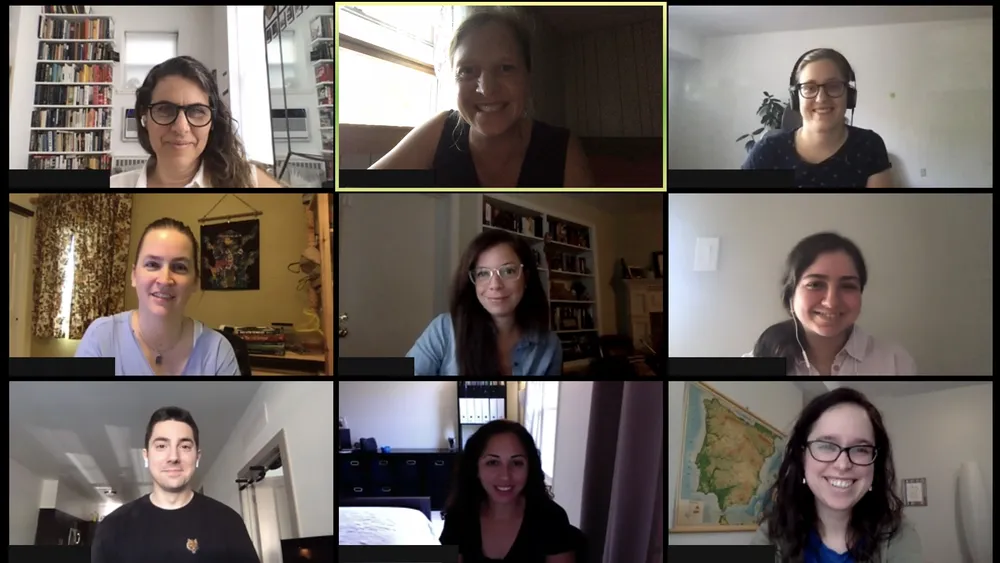Introducing the CDH-Princeton Geniza Project Research Partnership
23 July 2020
As Postgraduate Research Associate at CDH, I have attended two early meetings of the CDH-Princeton Geniza Project Research Partnership (CDH-PGP). So far, I have learned that the partnership is all about putting the pieces together.

At the Center for Digital Humanities, emojis are serious business.
We use emojis on Slack to support our colleagues (the blue heart is our signature) and to signal what we are working on. So when we were looking for an emoji to represent our new research partnership with the Princeton Geniza Project, Project Director Marina Rustow, Khedouri A. Zilkha Professor of Jewish Civilization in the Near East, stepped up.
Tweeting a gif of two manuscript fragments reconnecting, Rustow wrote: “it's a ‘join,’ parts of the same manuscript that time, chaos and entropy have severed and that scholars or algorithms have brought together again.”
It goes without saying: the emoji is now on CDH Slack.
The “join” emoji is particularly apt for the new collaboration. As Postgraduate Research Associate at CDH, I have attended two early meetings of the CDH-Princeton Geniza Project Research Partnership (CDH-PGP). So far, I have learned that the partnership is all about putting the pieces together.
First are the Geniza documents themselves. The PGP, part of the Princeton Geniza Lab, is a database of documents originally found in the Geniza chamber of the Ben Ezra Synagogue in Cairo, Egypt. Written in Judaeo-Arabic, Hebrew, Aramaic, and Arabic, the documents mostly date to the period 950-1200 and include letters and legal texts, among other categories. According to Rustow’s The Lost Archive (2020), the complete collection of documents, which is now spread across libraries and private collections around the world, includes approximately 400,000 folio pages—an indispensable resource for historians of the Middle East, scholars of Jewish studies, and others.
The PGP electronically brings together more than 28,000 (and counting) entries. The database allows users to search transcriptions of the documents and also to explore them using tags like “illness,” “tax,” and “love.” And, yes, you can search for “ joins,” too!
During this year-long Research Partnership Grant, CDH will focus on developing a new workflow for adding and editing Geniza transcriptions and translations, which will be linked to images through IIIF annotation. We will start developing a beta interface with improved search functionality and image-text integration to enable new kinds of scholarship based on these documents. Also planned are behind-the-scenes improvements, including better documentation to ensure that software, data structures, and workflows can be maintained for the long term.
The partnership will also bring together a diverse group of collaborators. We are thrilled to begin working with Rustow’s team, which already comprises Deena Abdel-Latif, coordinator of the Princeton Geniza Lab, and Stephanie Luescher and Rachel Richman, graduate students in the Department of Near Eastern Studies. Luescher and Richman will serve as project managers in the fall and spring semesters, respectively.
In addition, we are excited that the CDH-PGP Research Partnership will allow us to rethink project management (PM) for DH projects.
Earlier this summer, CDH Associate Director Natalia Ermolaev and Project and Education Coordinator Rebecca Munson participated in the the Project Management for the Humanities virtual conference, where they discussed how PM is not simply a set of best-practices, templates, and tools to administer projects; it also organizes the intellectual, technical, social, and ethical values of the project and team (see the Twitter hashtag #DHPM20 for excerpts from their paper).
Accordingly, we have been re-assessing our project charters, as we consider how we can better integrate development, design, research priorities, and community-building into the CDH project process.
As part of this initiative, various CDH team members are leading this summer’s virtual planning meetings, in which we define the goals for the year for the project charter. Several weeks ago, CDH Developer Nick Budak helped the group articulate roles and workflows, and this week, User Experience Designer Gissoo Doroudian will lead a session to make sure that all team members have a sophisticated understanding of the data before the charter is signed.
Can’t wait to witness the pieces falling into place.
Homepage image: Members of the CDH-Princeton Geniza Project Research Partnership team meet via Zoom this week.